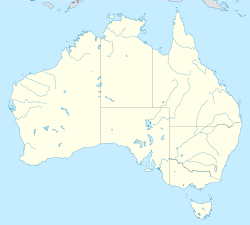Top Qs
Timeline
Chat
Perspective
Dalabon language
Australian Aboriginal language From Wikipedia, the free encyclopedia
Remove ads
Dalabon is a Gunwinyguan language of Arnhem Land, Australia. It is a severely endangered language,[3] with perhaps as few as three fluent speakers remaining as of 2018.[1] Dalabon is also known as Dangbon (the Kune or Mayali name), Ngalkbun (the Jawoyn name), and Buwan (the Rembarrnga name).[2]
This article includes a list of general references, but it lacks sufficient corresponding inline citations. (February 2025) |
Remove ads
Classification
Dalabon belongs to the Gunwinyguan languages branch of the Arnhem languages; its nearest relatives are Kunwinjku, Kune, Mayali (varieties often grouped together as Bininj Kunwok), and Kunbarlang. Its next closest relatives are Rembarrnga, and other languages within the Gunwinyguan family, including Jawoyn, Ngalakgan, Ngandi, Wubuy, and Enindhilyakwa.
Official status
Dalabon has no official status. Local schools spent years holding sporadic programs teaching Dalabon, but these operations did not receive enough governmental support. Therefore, the condition of the programs is still vulnerable.
Dialects
Given the limited number of Dalabon speakers, the study of dialects has become challenging to investigate. Speakers recall a distinction between two different types of speech, dalabon-djurrkdjurrk ("fast." "lively") and dalabon-murduk ("articulate"). However, no significant difference has been found between the two speeches.
Phonology and orthography
Summarize
Perspective
Consonants
There are 22 or 23 phonemic consonants in Dalabon, depending on the phonemic status of /h/. A table containing the consonant phonemes is given below with their orthographic representation (in angle brackets).
Vowels
There are 6 vowels in Dalabon. A table containing the vowel phonemes is given below with their orthographic representation (in angle brackets).
Phonotactics
Dalabon restricts the trilled [r] and long stops to only occur word-internally. Constraints regarding the edges of a phonological word also limit the glottal stop [ʔ] from occurring word-initially.
The syllable structure of Dalabon is CV(C)(C)(C), or more specifically:
CV(L)(N)(h) or CV(L)(S)
where:
- L is a liquid consonant (lateral or rhotic)
- N is a nasal consonant
- S is a peripheral consonant
- h is a glottal consonant.
Such complex codas are not unusual, and all combinations are enumerated as follows (words and translations taken from the dictionary[4]).
Complex coda of two consonants
Complex coda of three consonants
Phonological processes
Dalabon has a pattern of eliding unstressed vowels and unstressed syllables. For example, the word /'cabale/ 'shoulder blade' is often realized as ['cable].[5]
Prosody
The location of phrasal stress in Dalabon appears one or two peaks with an initial rise into the first peak at the left edge of the constituent and a final fall at the right edge of the constituent.[6]
Remove ads
Grammar
Summarize
Perspective
Although there is no complete grammatical description of the language, a number of aspects of Dalabon grammar have been described, including its bound pronominal system,[7] polysynthetic word structure,[8] verb conjugations,[9] the use of subordination strategies,[10] nominal subclasses,[11] the demonstrative system,[12] and the use of optional ergativity.[13]
Morphology
The structure of Dalabon verbs:[14]
- SEQ: sequential ‘and then’
- CAUS: ‘because’
- MISC: various adverbial type prefixes
- BEN: benefactive applicative
- GIN: ‘generic’ incorporated nouns
- BPIN: ‘body part’ incorporated nouns
- NUM: ‘number’ prefixes
- COM: comitative applicative
- RR: reflexive/reciprocal
- TAM: tense/aspect mood
The diminutive enclitic =wurd is derived from noun wurd 'woman's child', its reduplication wurdurd means 'child'. wurd can attach to most word classes and functions in 3 ways of meaning: to denote small objects, to add emotional connotations and to serve as pragmatic functions (especially for interactional softening). The examples are shown below.[15]
1.
to denote small objects
Bad-dulum-no=wurd
stone-hill-fill=DIM
kanidjah
there
ka-h-di.
3SG-R-stand/be.PRS
'There is a small stone hill there.' Unknown glossing abbreviation(s) (help);
2.
to add emotional connotations
Wa:h
INTERJ
ka-h-rakka-ng=wurd.
3SG-R-fall-PFV=DIM
'Oh, he fell over poor fellow.' Unknown glossing abbreviation(s) (help);
Syntax
Dalabon is a head-marking language. Dalabon has limited use of subordinate clauses, but it has a distinctive subordination strategy, which is to attach pronominal prefixes to the verb, and marked verbs are used for subordinate clause functions[16]
subordinate1: the unmarked form of prefixes to show subordinate status, used when the status is overt by other means.
subordinate2: used when prefixes are the only way to show subordination.
dis: disharmonic, meaning odd-numbered generations.
Examples are shown below:
(1)
bala-buh-ngong+boyenj-ni-nj
3pl-because-mob+big-be-PST.PFV
mahkih
because
‘..because there were so many of them.’
(2)
yila-h-yang-wona-wona-n
1pl/3-REAL-voice-REDUP-hear-PRES
yale-yu-yu.
1pl.SUBORD-REDUP-sleep.PRES
‘we heard his(dingo's) voice as we were sleeping.’
(3)
karrkkany
hawk.sp.
ka-h-ngun
3/3l-REAL-eat.PRES
kaye-do-n.
3.SUBORD-die-PRES
‘the hawk eats animals that die.’
Remove ads
Vocabulary
Remove ads
References
Further reading
External links
Wikiwand - on
Seamless Wikipedia browsing. On steroids.
Remove ads
